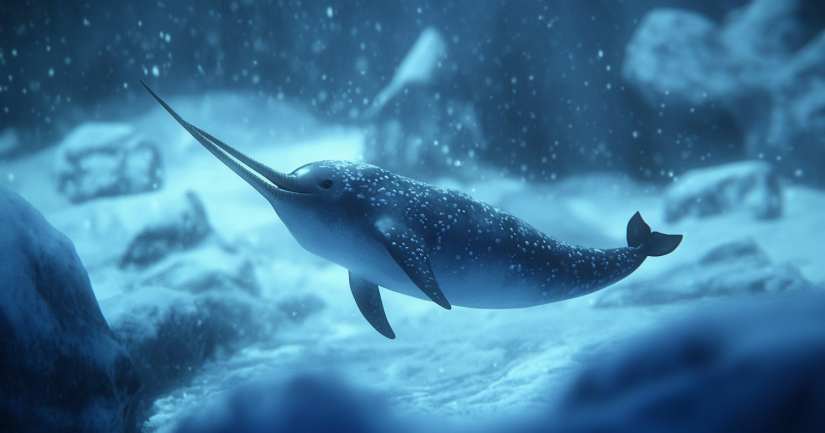
Narwhal Quiz Test Your Knowledge of the Unicorns of the Sea! Gliding through the icy waters of the Arctic, the narwhal is one of the most mysterious and elusive marine mammals in the world. Known for its long, spiraled tusk, this fascinating whale has captured the imagination of explorers, scientists, and storytellers for centuries earning it the nickname “the unicorn of the sea.” But how much do you really know about these deep-diving Arctic wonders? Take our Narwhal Quiz and discover the secrets of this extraordinary creature!
Narwhals belong to the toothed whale family and are closely related to belugas, though they stand apart due to their iconic, spiraled tusk, which is actually an overgrown tooth that can reach up to 10 feet (3 meters) long! Found exclusively in the Arctic, narwhals thrive in some of the harshest, coldest waters on the planet, diving deep beneath the ice in search of prey.
Narwhals are incredible creatures, but the wonders of the sea don’t end here! Learn about more ocean curiosities in our Mollusk Quiz or discover the sleek and swift marlin in the Marlin Quiz.
Mind-Blowing Narwhal Facts That Might Surprise You
Their Tusk Is Not a Horn—It’s a Tooth! – The narwhal’s famous “horn” is actually a modified canine tooth that grows straight through the upper lip and continues to spiral as the whale matures.
Not All Narwhals Have Tusks – While males typically have tusks, some females also develop them, while others remain tuskless their entire lives.
Narwhals Can Dive Over a Mile Deep – These Arctic whales are among the deepest-diving marine mammals, reaching depths of over 5,900 feet (1,800 meters) in search of food like squid, shrimp, and Arctic cod.
They Use Echolocation to Navigate Beneath the Ice – Since narwhals live in waters covered by sea ice, they rely on powerful clicks and sound waves to detect openings in the ice and find their way to the surface.
They Are Highly Social Creatures – Narwhals travel in pods of 10-20 individuals, though large gatherings of up to 1,000 narwhals have been observed during migrations.
Their Skin Is One of the Richest Sources of Vitamin C in the Arctic – Indigenous communities that traditionally hunt narwhals consume their muktuk (whale skin and blubber), which provides essential nutrients in an environment where fresh produce is scarce.
Scientists Are Still Unsure About the Purpose of the Narwhal’s Tusk – While some believe it is used for mating displays and dominance, recent studies suggest narwhals use their tusks as sensory organs to detect changes in the water, including temperature and salinity.
The Role of Narwhals in the Arctic Ecosystem
As top predators in the Arctic, narwhals help maintain healthy fish populations and play a vital role in the fragile polar ecosystem. However, they are increasingly threatened by climate change, melting sea ice, and human activity, including shipping noise that interferes with their echolocation abilities. Scientists continue to study narwhals to understand how they are adapting to their changing environment.
Are You Ready to Take the Ultimate Narwhal Quiz?
If you love marine biology, Arctic wildlife, or deep-sea mysteries, this Narwhal Quiz is perfect for you! Whether you’re fascinated by their legendary tusk, icy habitat, or incredible deep-diving abilities, this quiz will challenge your knowledge and reveal amazing facts about one of the ocean’s most elusive creatures.
So, are you ready to test your knowledge and dive into the world of narwhals? Take the Narwhal Quiz now and see if you’re a true Arctic whale expert!
Love the ocean? Test your knowledge with the Guess the Sea Animal Quiz, discover your marine match in the What Sea Animal Am I Quiz, or explore more Marine Quizzes for underwater fun!
Narwhal – FAQ
The narwhal is a unique species of whale found primarily in Arctic waters. Known for its long, spiral tusk, which can reach lengths of up to ten feet, this marine mammal is often referred to as the “unicorn of the sea.” Narwhals are closely related to beluga whales and are characterized by their distinctive greyish coloration.
Narwhals inhabit the icy waters of the Arctic, particularly around Greenland, Canada, and Russia. They are known to migrate seasonally, moving between summer feeding grounds in the open ocean and winter habitats in ice-covered regions. This adaptation allows them to thrive in extreme cold and to access their primary food sources, such as fish and squid.
Narwhals primarily feed on fish, including cod and halibut, as well as squid and shrimp. They are deep divers, capable of reaching depths of over 1,500 meters (approximately 4,920 feet) in search of food. Their echolocation abilities aid in locating prey in the dark, cold waters of the Arctic.
Yes, narwhals are currently classified as near threatened due to several factors, including climate change, hunting, and habitat loss. The melting of Arctic ice affects their environment and prey availability. Conservation efforts are underway to monitor their populations and protect their habitats.
Supporting organizations dedicated to Arctic conservation is a great way to help protect narwhals and their habitat. Additionally, raising awareness about the impacts of climate change and advocating for sustainable practices can contribute to the preservation of this remarkable species. Every effort counts in ensuring that future generations can appreciate the narwhal.
